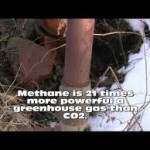EDITORIAL, Morgantown Dominion Post, September 14, 2012
A Groundswell of Skepticism – the report that spotlights abandoned oil and gas wells casts a shadow on the lack of enforcement.
In the beginning, we probably thought: What could ever go wrong for the oil and gas industry? But occasionally, a report comes along that leads us to think nothing can go right. Last year, the Department of Environmental Protection (DEP) released its State of the Environment report. As a rule, there are few surprises in these reports, but we could not help but note that report described 13,000 abandoned oil and gas wells in our state, defined as a dry hole or a well that’s been idle for a year.
These abandoned wells were said to pose minimal risks to the public, assuming they were built properly. And the DEP was focused on those that could cause problems, such as leaking sulfur or crude oil. The DEP secretary noted then that 13,000 of anything sounds like a large number. And he’s right, it does. Especially, if you’re the one coping with the fallout and costs of such wells. That report also noted the state had reclaimed or plugged about 250 such wells since 2004 at a cost of $6 million. Nobody said it was going to be cheap. But nobody said the state’s taxpayers were going to be footing the bill, either.
Then this week another report comes along. This one from legislative auditors. And that 13,000 figure? It’s still there. All right, so we’ll just have to accept that. However, it’s the gush of details that emerged with that figure we find troubling. For instance, the DEP’s Office of Oil and Gas cannot identify who last operated 5,800 of those wells, while the operators of another 4,700 of them have not indicated they plan to plug them or restart them within 10 years. And they’re in everyone’s backyard. All 55 counties.
Mind you, all of this is illegal. Operators are required to cap a well that’s dry or unused for 12 consecutive months, unless they can demonstrate a future use for the well. So, how many wells are exempt as a result of showing a future use? Would you believe 34?
And there’s more. The database used to track the more than 110,000 state wells doesn’t flag the ones that don’t post production numbers every 12 months? Inspectors don’t even visit these abandoned wells, and a random sampling of about 50 percent of them found that they had been inactive for five years, while 43 percent were unused for at least 10 years.
The analysts who prepared this audit also took exception with the DEP secretary on the dangers of these wells. They found collectively, these abandoned sites could be a significant hazard to public health and the environment. Is the sky falling? No, but the risks these abandoned wells pose on the ground is rising.


{ 2 comments… read them below or add one }
Well, I found this one of great interest and importance. We learn here of the importance of advance planning, of putting regulations and personnel in place before approving such incredibly large numbers of oil and gas wells.
I suspect, with a little research, you would find that a large percentage of the “36.1 percent” of the wells “listed as having no known operator” were drilled long before the state’s bonding requirements were put into place. Keep in mind that there is a 150-year-plus history of drilling wells in WV to produce petroleum. The 1920 WV Bluebook indicated that by the end of 1917 there had been as many as 60,000 to 70,000 wells drilled in WV. As to the other 64%, many are wells that could be put back into production, if gas prices recover. The requirement that such marginally economic wells be plugged now is onerous and counterproductive. Better that the state require that wells that our out of service because of current economics be shut-in at the surface and monitored for leaks on a regular basis, as long as the bond for abandonment is maintained and the operator believes that they may be able to produce the well in the future.